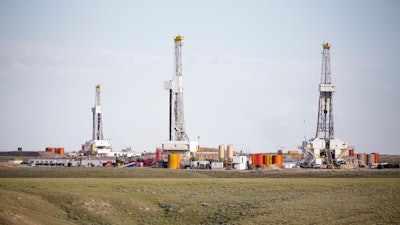
Over the last 10 years hydraulic fracturing had become the technique by which most natural gas is produced in the United States. Based on the most recent data from states, EIA estimates that natural gas production from hydraulically fractured wells now make up about two-thirds of total U.S. marketed gas production. This share of production is even greater than the share of crude oil produced using that method, where hydraulic fracturing accounts for about half of current U.S. crude oil production.
Hydraulic fracturing, often in combination with horizontal drilling, involves forcing a liquid (primarily water) under high pressure from a wellbore against a rock formation until it fractures. The fracture lengthens as the high-pressure liquid in the wellbore flows into the formation. This injected liquid contains a proppant, or small, solid particles (usually sand or a manmade granular solid of similar size), that fills the expanding fracture. When the injection is stopped and the pressure is reduced, the formation attempts to settle back into its original configuration, but the proppant keeps the fractures open. This allows hydrocarbons to flow from the rock formation back to the wellbore and then to the surface.
A profile of marketed natural gas production using well completion and production data from IHS Global Insight and DrillingInfo, Inc. shows that in 2000, approximately 26,000 hydraulically fractured wells produced 3.6 billion cubic per day (Bcf/d) of marketed gas in the U.S.. This represented less than seven percent of the national total.
By 2015, the number of hydraulically fractured wells had grown to an estimated 300,000, and production from those wells had grown to more than 53 Bcf/d, making up about 67 percent of the total natural gas output of the United States.
Natural gas production from hydraulic fracturing has primarily come from shale and other tight rocks in the Marcellus and Utica formations of the Appalachian Basin, the Bakken formation in Montana and North Dakota, the Eagle Ford formation in Texas, and the stacked Permian Basin formations in Texas and New Mexico.
Hydraulic fracturing is not limited to natural gas-containing formations such as shales or other source rocks, nor is it limited to horizontal wells. Hydraulic fracturing has been successfully used in directional and vertical wells, natural gas and oil wells, and in non-tight formations and reservoirs.
Monthly natural gas production by geologic formation can be found at EIA's Natural Gas Weekly Update. Production and other drilling metrics by geographic area can be found in EIA's Drilling Productivity Report.






















